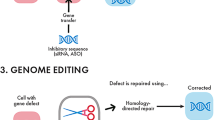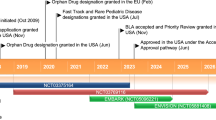Summary
The paediatric neurotransmitter diseases (PNDs) are a group of inborn errors of metabolism characterized by abnormalities of neurotransmitter synthesis or metabolism. Although some children may react favourably to neurotransmitter augmentation treatment, optimal response is not universal and other modes of treatment should be sought. The genes involved in many of the currently known monoamine PNDs have been utilized in pre-clinical and in phase I clinical trials in Parkinson disease (PD) and the basic principles could be applied to the therapy of PNDs with some modifications regarding the targeting and distribution of vectors. However, issues that go beyond neurotransmitter replacement are important considerations in PD and even more so in PNDs. Understanding the pathophysiology of PNDs including abnormal development resulting from the neurotransmitter deficiency will be critical for rational therapeutic approaches. Better animal models of PNDs are necessary to test gene therapy before clinical trials can be attempted.

Similar content being viewed by others
Abbreviations
- AADC:
-
aromatic l-amino acid decarboxylase
- AAV:
-
adeno-associated virus
- BH4 :
-
tetrahydrobiopterin
- GTPCH-I:
-
guanine triphosphate cyclohydrolase I
- HSV:
-
herpes simplex viruses
- LV:
-
lentiviruses
- PD:
-
Parkinson disease
- PND:
-
paediatric neurotransmitter disease
- PTPS:
-
6-pyruvoyl-tetrahydropterin synthase
- SR:
-
sepiapterin reductase
- TH:
-
tyrosine hydroxylase
- VMAT-2:
-
vesicular monoamine transporter
References
Alexander IE, Cunningham SC, Logan GJ, Christodoulou J (2008) Potential of AAV vectors in the treatment of metabolic disease. Gene Ther 15: 831–839. doi:10.1038/gt.2008.64.
Azzouz M, Martin-Rendon E, Barber RD, et al (2002) Multicistronic lentiviral vector-mediated striatal gene transfer of aromatic l-amino acid decarboxylase, tyrosine hydroxylase, and GTP cyclohydrolase I induces sustained transgene expression, dopamine production, and functional improvement in a rat model of Parkinson’s disease. J Neurosci 22: 10302–10312.
Bankiewicz KS, Forsayeth J, Eberling JL, et al (2006) Long-term clinical improvement in MPTP-lesioned primates after gene therapy with AAV-hAADC. Mol Ther 14: 564–570. doi:10.1016/j.ymthe.2006.05.005.
Bencsics C, Wachtel SR, Milstien S, Hatakeyama K, Becker JB, Kang UJ (1996) Double transduction with GTP cyclohydrolase I and tyrosine hydroxylase is necessary for spontaneous synthesis of l-DOPA by primary fibroblasts. J Neurosci 16: 4449–4456.
Cai S, Khoo J, Channon KM (2005) Augmented BH4 by gene transfer restores nitric oxide synthase function in hyperglycemic human endothelial cells. Cardiovasc Res 65: 823–831. doi:10.1016/j.cardiores.2004.10.040.
Chubakov AR, Gromova EA, Konovalov GV, Sarkisova EF, Chumasov EI (1986) The effects of serotonin on the morpho-functional development of rat cerebral neocortex in tissue culture. Brain Res 369: 285–297. doi:10.1016/0006-8993(86)90537-8.
Crystal RG, Sondhi D, Hackett NR, et al (2004) Clinical protocol. Administration of a replication-deficient adeno-associated virus gene transfer vector expressing the human CLN2 cDNA to the brain of children with late infantile neuronal ceroid lipofuscinosis. Hum Gene Ther 15: 1131–1154.
Davidoff AM, Gray JT, Ng CY, et al (2005) Comparison of the ability of adeno-associated viral vectors pseudotyped with serotype 2, 5, and 8 capsid proteins to mediate efficient transduction of the liver in murine and nonhuman primate models. Mol Ther 11: 875–888. doi:10.1016/j.ymthe.2004.12.022.
Ding Z, Harding CO, Rebuffat A, Elzaouk L, Wolff JA, Thony B (2008) Correction of murine PKU following AAV-mediated intramuscular expression of a complete phenylalanine hydroxylating system. Mol Ther 16: 673–681. doi:10.1038/mt.2008.17.
Eberling JL, Jagust WJ, Christine CW, et al (2008) Results from a phase I safety trial of hAADC gene therapy for Parkinson disease. Neurology 70: 1980–1983. doi:10.1212/01.wnl.0000312381.29287.ff.
Elzaouk L, Leimbacher W, Turri M, et al (2003) Dwarfism and low insulin-like growth factor-1 due to dopamine depletion in Pts−/− mice rescued by feeding neurotransmitter precursors and H4-biopterin. J Biol Chem 278: 28303–28311. doi:10.1074/jbc.M303986200.
Freed CR, Greene PE, Breeze RE, et al (2001) Transplantation of embryonic dopamine neurons for severe Parkinson’s disease. N Engl J Med 344: 710–719. doi:10.1056/NEJM200103083441002.
Gutlich M, Ziegler I, Witter K, et al (1994) Molecular characterization of HPH-1: a mouse mutant deficient in GTP cyclohydrolase I activity. Biochem Biophys Res Commun 203: 1675–1681. doi:10.1006/bbrc.1994.2379.
Hyland K, Gunasekara RS, Munk-Martin TL, Arnold LA, Engle T (2003) The hph-1 mouse: a model for dominantly inherited GTP-cyclohydrolase deficiency. Ann Neurol 54(Supplement 6): S46–48. doi:10.1002/ana.10695.
Hyman C, Hofer M, Barde YA, et al (1991) BDNF is a neurotrophic factor for dopaminergic neurons of the substantia nigra. Nature 350: 230–232. doi:10.1038/350230a0.
Jacobs BL, Azmitia EC (1992) Structure and function of the brain serotonin system. Physiol Rev 72: 165–229.
Janson C, McPhee S, Bilaniuk L, et al (2002) Clinical protocol. Gene therapy of Canavan disease: AAV-2 vector for neurosurgical delivery of aspartoacylase gene (ASPA) to the human brain. Hum Gene Ther 13: 1391–1412. doi:10.1089/104303402760128612.
Kang UJ, Lee WY, Chang JW (2001) Gene therapy for Parkinson’s disease: determining the genes necessary for optimal dopamine replacement in rat models. Hum Cell 14: 39–48.
Kang UJ, Nakamura K (2003) Potential of gene therapy for pediatric neurotransmitter diseases: lessons from Parkinson’s disease. Ann Neurol 54(Supplement 6):S103–109. doi:10.1002/ana.10654.
Kaplitt MG, Feigin A, Tang C, et al (2007) Safety and tolerability of gene therapy with an adeno-associated virus (AAV) borne GAD gene for Parkinson’s disease: an open label, phase I trial. Lancet 369: 2097–2105. doi:10.1016/S0140-6736(07)60982-9.
Kim DS, Froelick GJ, Palmiter RD (2002) Dopamine-dependent desensitization of dopaminergic signaling in the developing mouse striatum. J Neurosci 22: 9841–9849.
Kirik D, Georgievska B, Burger C, et al (2002) Reversal of motor impairments in parkinsonian rats by continuous intrastriatal delivery of L-dopa using rAAV-mediated gene transfer. Proc Natl Acad Sci U S A 99: 4708–4713. doi:10.1073/pnas.062047599.
Kordower JH, Chu Y, Hauser RA, Freeman TB, Olanow CW (2008) Lewy body-like pathology in long-term embryonic nigral transplants in Parkinson’s disease. Nat Med 14: 504–506. doi:10.1038/nm1747.
Lai CM, Lai YK, Rakoczy PE (2002) Adenovirus and adeno-associated virus vectors. DNA Cell Biol 21: 895–913. doi:10.1089/104454902762053855.
Laufs S, Blau N, Thony B (1998) Retrovirus-mediated double transduction of the GTPCH and PTPS genes allows 6-pyruvoyltetrahydropterin synthase-deficient human fibroblasts to synthesize and release tetrahydrobiopterin. J Neurochem 71: 33–40.
Laufs S, Kim SH, Kim S, Blau N, Thony B (2000) Reconstitution of a metabolic pathway with triple-cistronic IRES-containing retroviral vectors for correction of tetrahydrobiopterin deficiency. J Gene Med 2: 22–31. doi:10.1002/(SICI)1521-2254(200001/02)2:1<22::AID-JGM86>3.0.CO;2-1.
Lee WY, Chang JW, Nemeth NL, Kang UJ (1999) Vesicular monoamine transporter-2 and aromatic l-amino acid decarboxylase enhance dopamine delivery after l-3, 4-dihydroxyphenylalanine administration in Parkinsonian rats. J Neurosci 19: 3266–3274.
Leff SE, Spratt SK, Snyder RO, Mandel RJ (1999) Long-term restoration of striatal l-aromatic amino acid decarboxylase activity using recombinant adeno-associated viral vector gene transfer in a rodent model of Parkinson’s disease. Neuroscience 92: 185–196. doi:10.1016/S0306-4522(98)00741-6.
Lewis TB, Standaert DG (2008) Design of clinical trials of gene therapy in Parkinson disease. Exp Neurol 209: 41–47. doi:10.1016/j.expneurol.2007.08.012.
Li JY, Englund E, Holton JL, et al (2008) Lewy bodies in grafted neurons in subjects with Parkinson’s disease suggest host-to-graft disease propagation. Nat Med 14: 501–503. doi:10.1038/nm1746.
Limousin P, Martinez-Torres I (2008) Deep brain stimulation for Parkinson’s disease. Neurotherapeutics 5: 309–319. doi:10.1016/j.nurt.2008.01.006.
Lowenstein PR, Mandel RJ, Xiong WD, Kroeger K, Castro MG (2007) Immune responses to adenovirus and adeno-associated vectors used for gene therapy of brain diseases: the role of immunological synapses in understanding the cell biology of neuroimmune interactions. Curr Gene Ther 7: 347–360. doi:10.2174/156652307782151498.
Luo J, Kaplitt MG, Fitzsimons HL, et al (2002) Subthalamic GAD gene therapy in a Parkinson’s disease rat model. Science 298: 425–429. doi:10.1126/science.1074549.
Mandel RJ, Burger C, Snyder RO (2008) Viral vectors for in vivo gene transfer in Parkinson’s disease: properties and clinical grade production. Exp Neurol 209: 58–71. doi:10.1016/j.expneurol.2007.08.008.
Marks WJ Jr, Ostrem JL, Verhagen L, et al (2008) Safety and tolerability of intraputaminal delivery of CERE-120 (adeno-associated virus serotype 2-neurturin) to patients with idiopathic Parkinson’s disease: an open-label, phase I trial. Lancet Neurol 7: 400–408. doi:10.1016/S1474-4422(08)70065-6.
Medina MA, Urdiales JL, Rodriguez-Caso C, Ramirez FJ, Sanchez-Jimenez F (2003) Biogenic amines and polyamines: similar biochemistry for different physiological missions and biomedical applications. Crit Rev Biochem Mol Biol 38: 23–59. doi:10.1080/713609209.
Meininger CJ, Cai S, Parker JL, et al (2004) GTP cyclohydrolase I gene transfer reverses tetrahydrobiopterin deficiency and increases nitric oxide synthesis in endothelial cells and isolated vessels from diabetic rats. FASEB J 18: 1900–1902.
Olanow CW, Goetz CG, Kordower JH, et al (2003) A double-blind controlled trial of bilateral fetal nigral transplantation in Parkinson’s disease. Ann Neurol 54: 403–414. doi:10.1002/ana.10720.
Palfi S (2008) Towards gene therapy for Parkinson’s disease. Lancet Neurol 7: 375–376. doi:10.1016/S1474-4422(08)70066-8.
Pearl PL, Taylor JL, Trzcinski S, Sokohl A (2007) The pediatric neurotransmitter disorders. J Child Neurol 22: 606–616. doi:10.1177/0883073807302619.
Porras G, Bezard E (2008) Preclinical development of gene therapy for Parkinson’s disease. Exp Neurol 209: 72–81. doi:10.1016/j.expneurol.2007.08.003.
Royo NC, Vandenberghe LH, Ma JY, et al (2008) Specific AAV serotypes stably transduce primary hippocampal and cortical cultures with high efficiency and low toxicity. Brain Res 1190: 15–22. doi:10.1016/j.brainres.2007.11.015.
Sanchez-Pernaute R, Harvey-White J, Cunningham J, Bankiewicz KS (2001) Functional effect of adeno-associated virus mediated gene transfer of aromatic l-amino acid decarboxylase into the striatum of 6-OHDA-lesioned rats. Mol Ther 4: 324–330. doi:10.1006/mthe.2001.0466.
Sodhi MS, Sanders-Bush E (2004) Serotonin and brain development. Int Rev Neurobiol 59: 111–174. doi:10.1016/S0074-7742(04)59006-2.
Taymans JM, Vandenberghe LH, Haute CV, et al (2007) Comparative analysis of adeno-associated viral vector serotypes 1, 2, 5, 7, and 8 in mouse brain. Hum Gene Ther 18: 195–206. doi:10.1089/hum.2006.178.
Thony B, Leimbacher W, Stuhlmann H, Heizmann CW, Blau N (1996) Retrovirus-mediated gene transfer of 6-pyruvoyl-tetrahydropterin synthase corrects tetrahydrobiopterin deficiency in fibroblasts from hyperphenylalaninemic patients. Hum Gene Ther 7: 1587–1593. doi:10.1089/hum.1996.7.13–1587.
Wachtel SR, Bencsics C, Kang UJ (1997) Role of aromatic l-amino acid decarboxylase for dopamine replacement by genetically modified fibroblasts in a rat model of Parkinson’s disease. J Neurochem 69: 2055–2063.
Winkler C, Kirik D, Bjorklund A (2005) Cell transplantation in Parkinson’s disease: how can we make it work? Trends Neurosci 28: 86–92. doi:10.1016/j.tins.2004.12.006.
Zesiewicz TA, Sullivan KL, Hauser RA (2007) Levodopa-induced dyskinesia in Parkinson’s disease: epidemiology, etiology, and treatment. Curr Neurol Neurosci Rep 7: 302–310. doi:10.1007/s11910-007-0046-y.
Zhou QY, Palmiter RD (1995) Dopamine-deficient mice are severely hypoactive, adipsic, and aphagic. Cell 83: 1197–1209. doi:10.1016/0092-8674(95)90145-0.
Zhou QY, Quaife CJ, Palmiter RD (1995) Targeted disruption of the tyrosine hydroxylase gene reveals that catecholamines are required for mouse fetal development. Nature 374: 640–643. doi:10.1038/374640a0.
Acknowledgement
M.R. is a recipient of a fellowship grant from the Paediatric Neurotransmitter Disease Association. U.J.K. was supported by NIH grant R01NS32080, Parkinson Disease Foundation, and American Parkinson Disease Association for the research described in the review. We thank Keith Hyland for helpful discussions.
The Symposium was supported in part by R13 NS 60363 from the NIH NINDS and Office of Rare Diseases (ORD), and the Johns Hopkins University School of Medicine.
Author information
Authors and Affiliations
Corresponding author
Additional information
Communicating editor: Michael Gibson
Competing interests: None declared
Rights and permissions
About this article
Cite this article
Rotstein, M., Kang, U.J. Consideration of gene therapy for paediatric neurotransmitter diseases. J Inherit Metab Dis 32, 387–394 (2009). https://doi.org/10.1007/s10545-009-1054-7
Received:
Revised:
Accepted:
Published:
Issue Date:
DOI: https://doi.org/10.1007/s10545-009-1054-7




